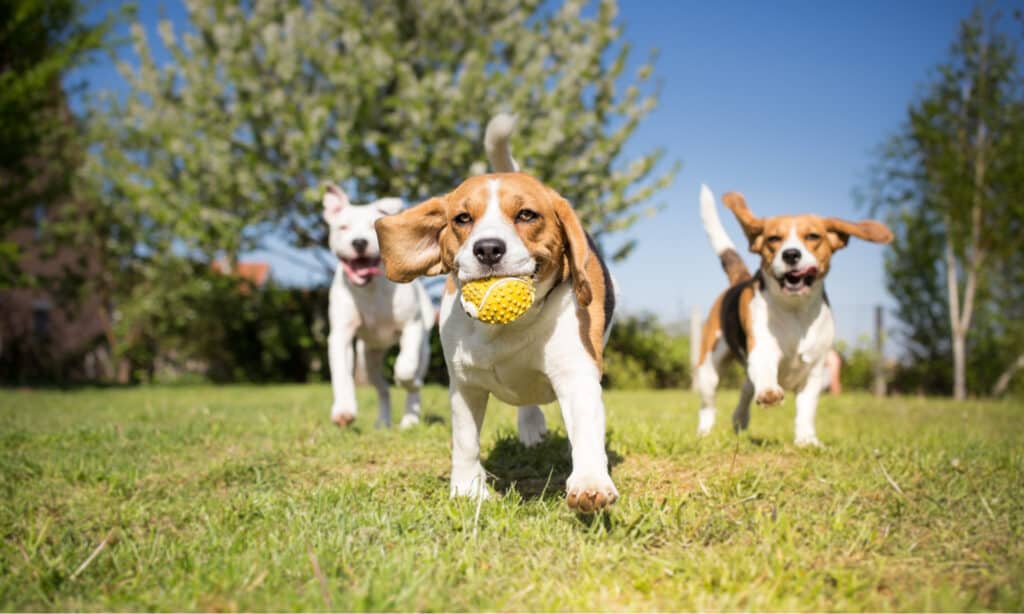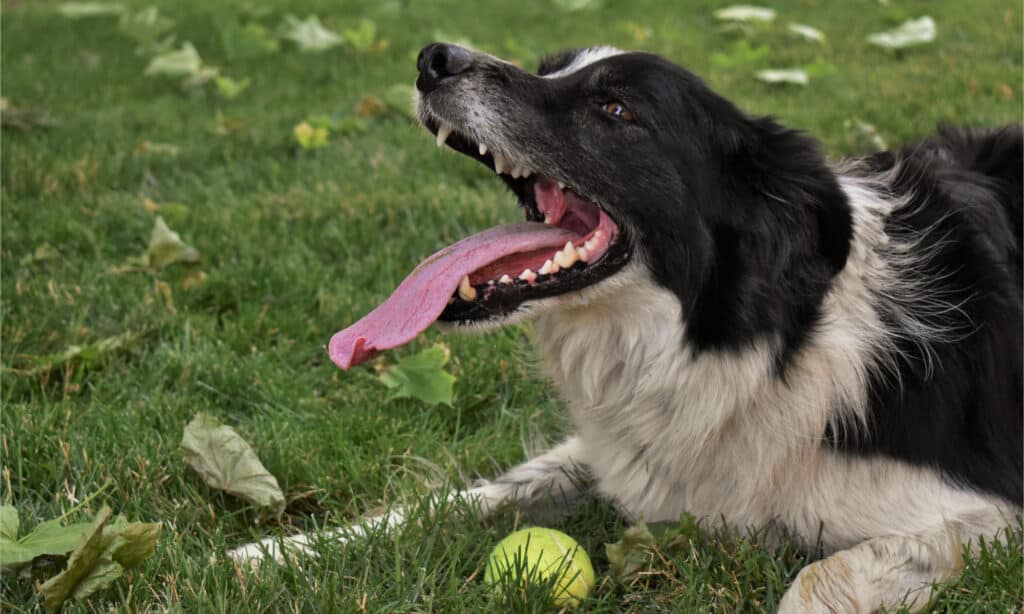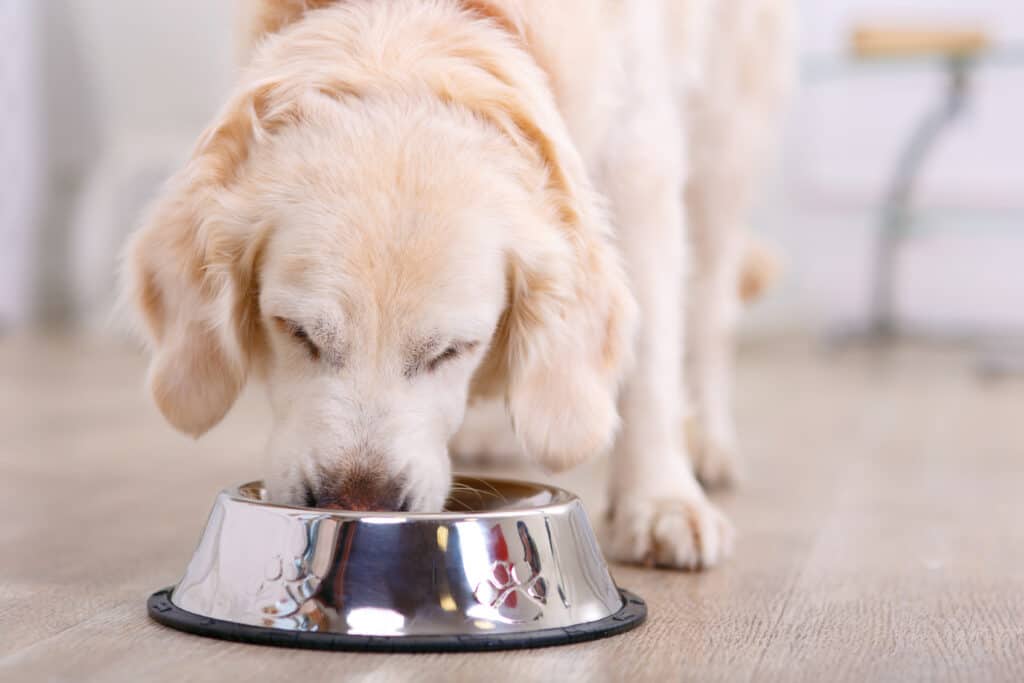Humans and dogs alike both need water in order to stay alive. Without proper hydration, the body cannot function properly. Typically a dog can go up to 72 hours (three days) without water but will start to show signs of dehydration within as little as 24 hours. Dehydration can be very harmful to your dog’s health so it’s important to know how to keep them hydrated. Read on to learn more about dehydration in dogs and how long your dog can go without water safely.
How Do Dogs Become Dehydrated?

Dogs can become dehydrated by sweating after they become too hot
©oneinchpunch/Shutterstock.com
Just like people, dogs can become dehydrated when fluids leave the body through sweat, urination, and defecation. You may be surprised to learn that dogs do sweat—just not the same way as we do. Dogs sweat through the glands in their paws. It’s important to note that you should never shave your dog’s fur in an attempt to keep them cool, as this will have the opposite effect. Dogs do not sweat through their skin as we do, so shaving their fur off will not help keep them cool. Shaving off all of a dog’s fur can actually lead to heat stroke in dogs, which can be fatal. You may never actually notice that your dog sweats and that’s because of the manner in which they do. Dogs sweat through two types of sweat glands. They are called Merocrine glands and Apocrine glands.
Merocrine glands
The merocrine glands found on a dog’s paws function in a way that’s similar to how a human’s sweat glands function. When a dog’s body temperature rises and it needs to cool itself down, the merocrine glands in the dog’s paws begin to activate and release sweat. You might notice that your dog leaves wet paw prints on the ground when walking around during warm weather. This is the sweat being produced from their paws.
Apocrine glands
Apocrine sweat glands are located all over a dog’s body, but they work differently than merocrine glands do. Most veterinarians do consider apocrine glands to be sweat glands, however, they do not release sweat. The main purpose of apocrine glands is to release pheromones rather than sweat. This means that they do not function to cool off a dog’s body. These are the glands that help dogs identify each other by their scent.
The reason that dogs don’t sweat from their bodies as we do is that most dogs are covered in fur. If they were to sweat from their bodies, the sweat would not be able to evaporate properly due to the fur. The process of sweat evaporating from the skin is what helps cool the body down when it’s too hot—therefore if a dog were to sweat from its body, its fur would prevent it from cooling itself down.
Why Do Dogs Pant?

Dogs cool down by panting as moisture evaporates from their tongue
©Diane Isabel/Shutterstock.com
Since dogs do not sweat from their bodies, they have to cool their bodies down somehow. Dogs are able to do this through the act of panting. Panting helps control a dog’s body temperature because the moisture evaporates from their tongues, their nasal passages, and even from the lining of their lungs. This helps cool them down since the air they take in from panting passes over the moist areas.
Another way that dogs help keep themselves cool is by a process called vasodilation. This is where a dog’s blood vessels that are located in its ears and in its face expand and pull the hot blood closer to the skin’s surface. This helps cool the blood down before it makes its journey back throughout the body and to the heart. This process helps regulate the dog’s internal body temperature, keeping it from overheating.
Symptoms of Dehydration in Dogs

Fatigue is just one symptom of dehydration in dogs
©NayaDadara/Shutterstock.com
It is critical to be able to recognize the signs of dehydration in a dog right away. Here are some things you should be on the lookout for to know if your dog is dehydrated:
- Loss of appetite
- Loss of elasticity in the skin
- Panting
- Fatigue
- Loss of energy
- Vomiting
- Diarrhea
- Hollow or dry eyes
- Thick saliva
- Dry nose and gums
Paying close attention to any of these signs will help you determine if your dog is suffering from dehydration. You can also check the elasticity of your dog’s skin by gently pinching the dog’s skin between your fingers in the spot between the dog’s shoulder blades. Lift the dog’s skin carefully and then gently release it. Watch how the dog’s skin returns to its original place. If the dog is properly hydrated, the skin will quickly fall back into its place. However, if the dog is dehydrated, the skin will take longer to return to its place. You can do this same test on your arm to determine if you are adequately hydrated as well.
Another way you can check to see if your dog is hydrated or not is to take a look at your dog’s gums. You can gently press into your dog’s gums with your finger and check to see what color it turns. If the area you pressed turns white and then quickly returns to pink, the dog is properly hydrated. If, however, the gums do not quickly return to being pink, it means that your dog is dehydrated. The dog’s capillary refill takes longer for those that are dehydrated.
What Do I Do if My Dog Is Dehydrated?

Drinking water can help with dehydration
©Scott Biales DitchTheMap/Shutterstock.com
If you’ve determined that your dog is dehydrated, you will need to work quickly to help them recover. Let’s go over a few things you can do to help get your dog rehydrated:
Bring Your Dog Inside
If your dog was outdoors in hot weather, the first thing you should do is bring it indoors if possible. Getting your dog inside where it’s cooler will help prevent the dehydration from worsening. If it is not possible to get the dog indoors, move it to a spot that has plenty of shade and is out of direct sunlight. If your dog was already indoors, make sure the indoor temperature is comfortable or bring a fan into the room to help keep it cool.
Encourage Your Dog to Drink Water
Always be sure that your dog has plenty of water to drink and that its water bowl is kept fresh. Check with your vet to determine the right amount of water that your dog should be drinking for its size, weight, and health. If you have a small dog, you can give it about 1/8 cup of water each hour in order to rehydrate it. For larger dogs, you can give them about 1/4 cup of water per hour.
Monitor your dog closely over the next few hours to see if its condition is improving. If your dog does not seem to improve or its condition worsens, you should get your dog to the vet immediately for further examination.
How Long Does It Take for Dogs to Recover From Dehydration?
The length of time that it will take for your dog to recover from being dehydrated depends on how severe the case of dehydration was. If the symptoms were only mild, your dog may recover very quickly once it is in a cooler environment and has had enough water to drink. If, however, the symptoms were moderate or more severe, the recovery process may take longer, especially if the dog’s organs suffered any damage. In some situations, your dog may have to stay overnight at the vet while they receive IV fluids to help them rehydrate.
How to Prevent Dehydration in Dogs

Always ensure your dog has plenty of clean, fresh water to prevent dehydration
©Dmytro Zinkevych/Shutterstock.com
You can protect your dog from the harmful impacts of dehydration by taking a few easy precautions. The first and easiest thing to do is make sure that your dog has plenty of clean water to drink every day. Be sure that its water bowl always has water available in it—especially on hot days.
Also, make sure that the water bowl is the appropriate size for the size dog that you have. Larger dog breeds will need to have a bigger water bowl than smaller dogs. You can also have multiple water bowls located in different areas of the house so that it always has some nearby. For households with more than one dog, there should always be multiple water bowls or other sources of fresh water like water fountains for them to drink from.
You can also consider feeding your dog wet dog food. Wet food has more moisture in it and helps keep your dog hydrated much more than dry kibble. If your dog only consumes dry dog food, it will need to consume much more water to keep hydrated.
Another thing to consider is if you’re going to be outdoors, you should bring water with you so that your dog can rehydrate by using a dog water bottle. You can also pack cool treats with you like ice cubes or frozen fruit treats. These will help keep your dog hydrated and provide it will beneficial nutrients that it may not be getting from its food. The electrolytes in fruit will also help your dog stay hydrated more easily than water alone.
Up Next
- The 5 Best Dog Water Fountains, We Checked
- The 6 Best Dog Water Bottles: Reviewed for 2022
- The Surprising Way Dogs Drink Water (Not Obvious)
- Why Does My Dog Drink so Much Water?
The photo featured at the top of this post is © Dmytro Zinkevych/Shutterstock.com
Ready to discover the top 10 cutest dog breeds in the entire world?
How about the fastest dogs, the largest dogs and those that are -- quite frankly -- just the kindest dogs on the planet? Each day, AZ Animals sends out lists just like this to our thousands of email subscribers. And the best part? It's FREE. Join today by entering your email below.
Sources
- TPLO Info, Available here: https://tploinfo.com/blog/staying-hydrated-how-to-treat-dog-dehydration-at-home/
- American Kennel Club, Available here: https://www.akc.org/expert-advice/health/do-dogs-sweat/
Thank you for reading! Have some feedback for us? Contact the AZ Animals editorial team.






